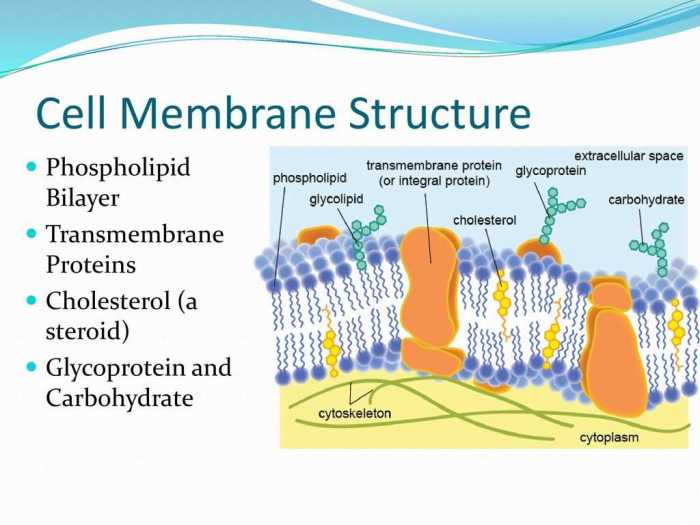Embark on an enlightening journey with our comprehensive Cell Membrane Webquest Answer Key, a gateway to unraveling the intricacies of the cellular barrier. This authoritative guide unlocks the secrets of membrane structure, function, and dynamics, empowering you with a profound understanding of this fundamental component of life.
Our meticulous exploration delves into the structure of the cell membrane, deciphering the role of the phospholipid bilayer in maintaining membrane integrity. We elucidate the functions of membrane proteins, unraveling their significance in transport, signaling, and cell recognition. Moreover, we illuminate the mechanisms of membrane transport, contrasting passive and active transport processes, and highlighting the role of membrane channels in ion movement.
Cell Membrane Structure and Function

The cell membrane, also known as the plasma membrane, is a thin, flexible barrier that surrounds all living cells. It plays a crucial role in maintaining cell integrity, regulating the exchange of materials between the cell and its surroundings, and facilitating communication between cells.The
cell membrane is composed primarily of a phospholipid bilayer, a double layer of phospholipids. Phospholipids are molecules with a hydrophilic (water-loving) head and a hydrophobic (water-hating) tail. In the cell membrane, the hydrophilic heads face outward, interacting with the aqueous environment, while the hydrophobic tails face inward, creating a nonpolar core.
This arrangement forms a selectively permeable barrier that allows certain substances to pass through while blocking others.Embedded within the phospholipid bilayer are various membrane proteins. These proteins perform a wide range of functions, including transport, signaling, and cell recognition. Transport proteins facilitate the movement of molecules across the membrane, either passively (down a concentration gradient) or actively (against a concentration gradient).
Signaling proteins transmit signals from the outside of the cell to the inside, triggering specific cellular responses. Cell recognition proteins allow cells to recognize and interact with each other, enabling processes such as cell adhesion and communication.
Membrane Transport
Membrane transport is the movement of molecules across the cell membrane. There are two main types of membrane transport mechanisms: passive transport and active transport.Passive transport occurs down a concentration gradient, from an area of high concentration to an area of low concentration.
This type of transport does not require energy input. Examples of passive transport include diffusion, which is the movement of molecules from an area of high concentration to an area of low concentration, and osmosis, which is the movement of water across a semipermeable membrane from an area of high water concentration to an area of low water concentration.Active
transport occurs against a concentration gradient, from an area of low concentration to an area of high concentration. This type of transport requires energy input. Examples of active transport include ion pumps, which use energy to pump ions across the membrane, and facilitated diffusion, which is the movement of molecules across the membrane with the assistance of a membrane protein.Membrane
channels are specialized membrane proteins that allow ions to move across the membrane. Ion channels are essential for maintaining the electrical balance of the cell and for transmitting electrical signals.
Cell Signaling
Cell signaling is the process by which cells communicate with each other. Membrane receptors are proteins that bind to specific signaling molecules, triggering a cellular response. There are two main types of cell signaling pathways: G-protein coupled receptors and receptor tyrosine kinases.G-protein
coupled receptors are membrane proteins that bind to specific signaling molecules, causing a conformational change that activates a G-protein. The G-protein then activates other proteins inside the cell, leading to a cellular response.Receptor tyrosine kinases are membrane proteins that bind to specific signaling molecules, causing a conformational change that activates the tyrosine kinase domain of the receptor.
The receptor tyrosine kinase then phosphorylates other proteins inside the cell, leading to a cellular response.Membrane fluidity is important for cell signaling because it allows membrane receptors to move laterally within the membrane, enabling them to interact with each other and with signaling molecules.
Membrane Fluidity and Membrane Asymmetry, Cell membrane webquest answer key
Membrane fluidity is the ability of the cell membrane to move and flow. It is important for cell function because it allows the membrane to adapt to changes in the environment and to facilitate the movement of molecules across the membrane.Membrane
fluidity is affected by a number of factors, including temperature and lipid composition. Temperature affects membrane fluidity because it changes the physical state of the lipids in the membrane. Lipid composition affects membrane fluidity because different lipids have different physical properties.Membrane
asymmetry is the difference in lipid and protein composition between the two leaflets of the cell membrane. It is important for cell function because it helps to maintain cell polarity and function.
Membrane Dynamics
Membrane dynamics refers to the changes that occur in the cell membrane over time. These changes include the movement of molecules across the membrane, the fusion and fission of membrane vesicles, and the recycling of membrane components.Membrane trafficking is the movement of molecules across the membrane.
There are three main types of membrane trafficking mechanisms: exocytosis, endocytosis, and phagocytosis.Exocytosis is the process by which molecules are released from the cell. Endocytosis is the process by which molecules are taken into the cell. Phagocytosis is a specialized form of endocytosis in which the cell engulfs large particles.Membrane
fusion and fission are the processes by which membrane vesicles are formed and destroyed. Membrane fusion is the process by which two membrane vesicles combine to form a single vesicle. Membrane fission is the process by which a single membrane vesicle is divided into two smaller vesicles.Membrane
lipids and proteins play a role in regulating membrane dynamics. Membrane lipids affect membrane fluidity, which in turn affects the movement of molecules across the membrane. Membrane proteins can interact with each other and with membrane lipids to regulate membrane dynamics.
Membrane Disorders
Membrane disorders are diseases that affect the cell membrane. These disorders can be caused by genetic or environmental factors.Common membrane disorders include cystic fibrosis, sickle cell anemia, and Tay-Sachs disease. Cystic fibrosis is a genetic disorder that affects the chloride channels in the cell membrane.
Sickle cell anemia is a genetic disorder that affects the shape of red blood cells. Tay-Sachs disease is a genetic disorder that affects the metabolism of lipids in the cell membrane.The symptoms of membrane disorders vary depending on the specific disorder.
Common symptoms include fatigue, weakness, muscle cramps, and pain.There are a number of different treatment options for membrane disorders. These treatments include medications, surgery, and gene therapy.
Essential Questionnaire: Cell Membrane Webquest Answer Key
What is the primary function of the cell membrane?
The cell membrane serves as a selective barrier, regulating the movement of substances into and out of the cell, maintaining cellular homeostasis.
How does passive transport differ from active transport?
Passive transport involves the movement of substances across the membrane without energy expenditure, following concentration gradients. In contrast, active transport requires energy input to move substances against concentration gradients.
What is the role of membrane fluidity in cell function?
Membrane fluidity is crucial for various cellular processes, including membrane trafficking, signal transduction, and cell division. It allows the membrane to adapt to changing conditions and maintain its functionality.
